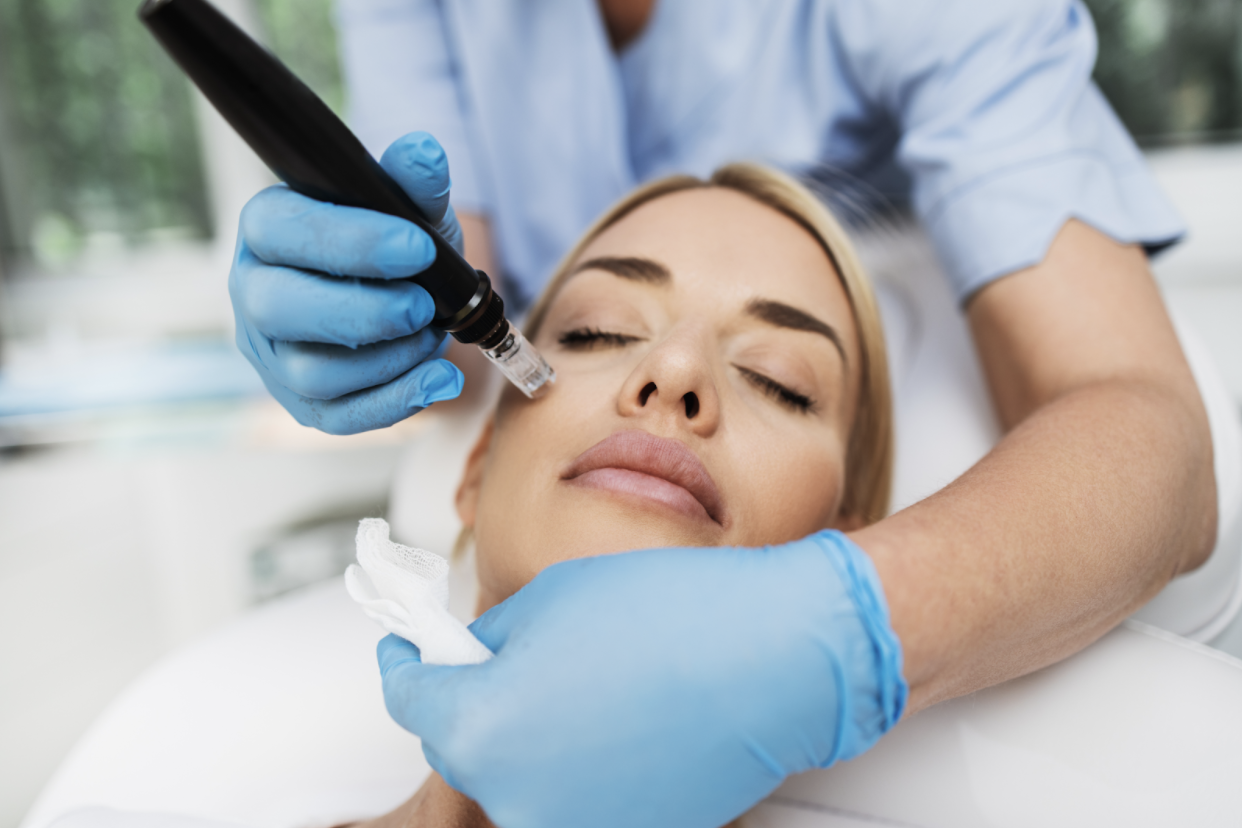
Fast Facts about Micro-needling:
About:
- Micro-needling is a dermal-roller or mechanical device procedure that uses tiny needles to prick the skin.
- The purpose of treatment is to generate new collagen and skin tissue for smoother, firmer, more toned skin.
- Micro-needling is mainly used on the face and may treat various scars, wrinkles, and large pores.
Safety:
- Micro-needling is minimally invasive, requiring no downtime.
- It’s considered safe for most people who are in overall good health.
- The procedure isn’t safe for people who use certain acne medications or for women who are pregnant.
- You’ll experience minor redness and irritation for a few days after the procedure.
Convenience:
- Total prep and procedure time is about two hours.
- You’ll need to see a Facial specialist to receive micro-needling at a certain dept such as a Maxillofacial Surgeon, Plastic Surgeon, Dermatologist, or Nurse. In some states, such as Arizona, an aesthetician may also perform the procedure to the same medical depth if supervised by a physician. The Micro-needing you may receive from an esthetician outside of a medical setting will not be at the same depth as the one done within a medical specialty clinic.
- You may need at least four procedures or more for the best results.
Cost:
- Micro-needling can cost anywhere from $100 to $700 per session. The overall costs depend on the size of the area being worked on.
- It’s not covered by insurance.
Efficacy:
- It’s considered effective in treating minor scarring related to acne, wounds, and aging. You’ll likely notice brighter, firmer skin, too.
- Ideal results are achieved after multiple sessions.
- Micro-needling is far more effective than at-home rollers.
What is micro-needling?
Micro-needling is a minimally invasive cosmetic procedure that’s used to treat skin concerns via collagen production. Also known as collagen induction therapy, this treatment may help those looking to reduce the appearance of acne scars and stretch marks.
It’s also used in certain anti-aging procedures, such as eyelid surgery and sunspots.
You may be an ideal candidate for this procedure if you’re in good health and have certain skin concerns that haven’t responded to home treatments or other types of dermatologic procedures, such as peels.
This may also be a final step before considering cosmetic surgery for anti-aging and other concerns. Learn more about micro-needling and talk to your dermatologist to see if this is the right option for your skin.
How much does micro-needling cost?
According to estimates by Skin Pen, micro-needling costs from $100 to $700 per session. Most face treatments run around $300 each session.
Since micro-needling is considered a cosmetic or aesthetic procedure, it’s not covered by insurance. Your doctor may be able to help you afford your treatments better by structuring a payment plan for you. Some offices even offer to finance.
How does it work:
Micro-needling works by encouraging your skin to make more collagen. The idea is that pinpricks from the procedure cause slight injury to the skin and respond by making new collagen-rich tissue.
This new skin tissue is, in turn, more even in tone and texture. It’s normal for the skin to lose collagen via age or injury. By encouraging the skin to make new tissue, there may be more collagen to help make the skin firmer, too.
Procedure for micro-needling
During the procedure, your doctor makes small pricks under the skin with a pen-like tool. The pinpricks are so small that you likely won’t notice them after the procedure. Your doctor will move the tool evenly across your skin so that the new skin that rejuvenates will be even, too.
Before getting started, your doctor will use a topical anesthetic to reduce the chances of pain. This is done about an hour before your treatment. The actual micro-needling process takes approximately 30 minutes.
Your doctor may then apply a serum or calming treatment. In total, you can expect to be at the office for a couple of hours at least.
Targeted areas for micro-needling
Micro-needling is most often used on your face to target:
- acne scars
- age spots (also called “sun spots”)
- fine lines and wrinkles
- large pores
- other scars
- skin elasticity improvements
- uneven skin tone
In addition to facial concerns, micro-needling is sometimes used to treat stretch marks in other areas of the body. Scarring on other body parts may also be treated with this procedure. However, micro-needling is primarily used on the face.
Are there any risks or side effects?
Like all cosmetic procedures, micro-needling isn’t without risk. The most common side effect is minor skin irritation immediately following the procedure. You may also see redness for a few days. Call your doctor if you notice more severe side effects, such as:
- bleeding
- bruising
- infection
- peeling
What to expect after micro-needling
Micro-needling isn’t invasive like plastic surgery, so the recovery time is minimal. You may notice skin irritation and redness within the first few days following the procedure. This is a natural response to the small “injuries” made by the needles in your skin.
You can go back to work or school after the procedure if you’re comfortable. Some people apply camouflage makeup during the first few days as the redness dissipates.
Your skin will also be more sensitive to the sun; sunscreen is a must.
After micro-needling, your skin works fairly quickly to rejuvenate new tissue. In theory, you should see results within a couple of weeks.
To maintain the results of your treatment, you’ll need multiple sessions and perhaps other complementing treatments. Your doctor will advise you on the best plan of action based on your individual goals.
Preparing for micro-needling
Before the procedure, talk to your doctor about ways you can prepare so you have the best possible outcome. You may need to stop taking certain medications, such as ibuprofen and those for acne treatment, well before the procedure.
Back to Blog
All Rights Reserved. Web Design & Internet Marketing by Studio III
